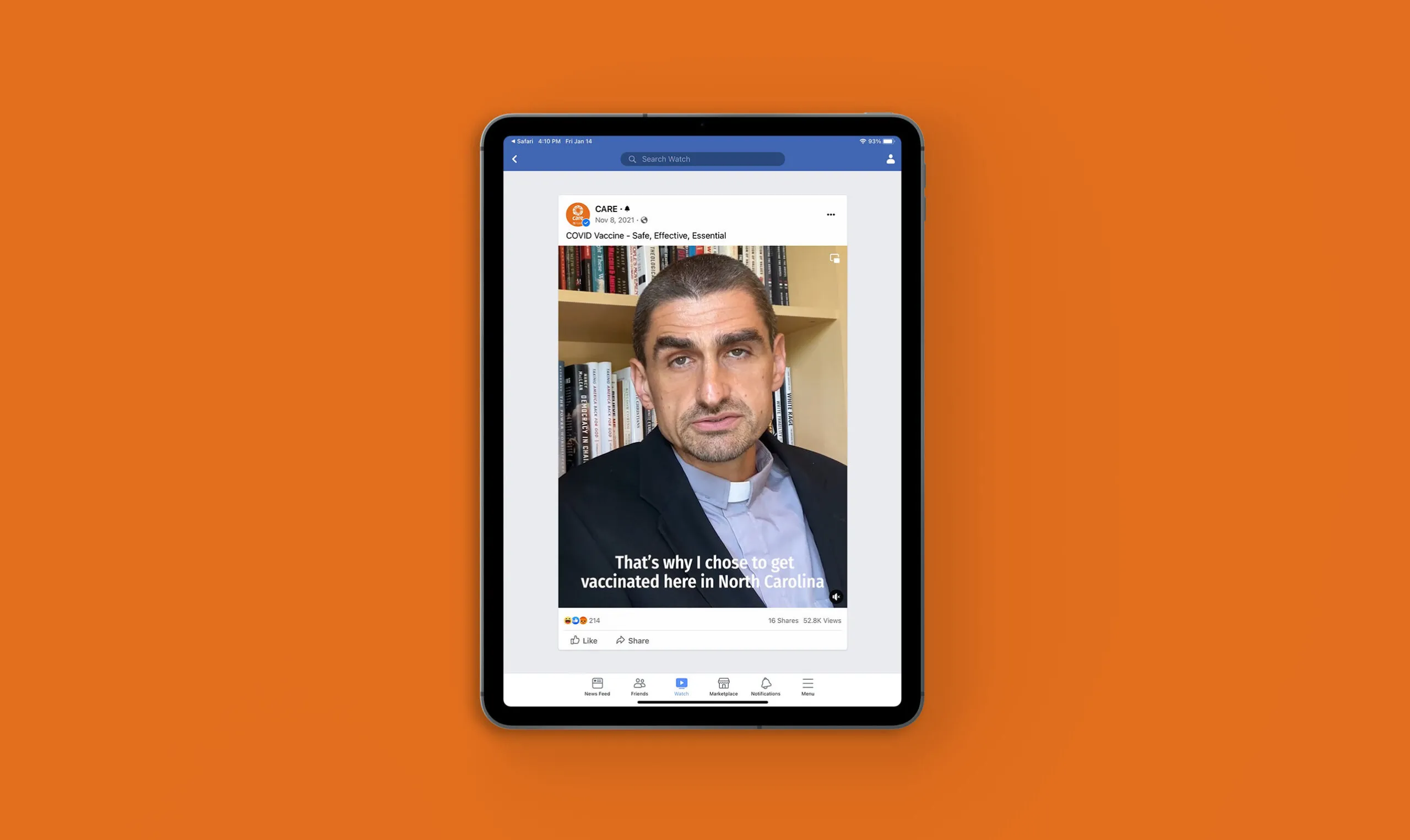The TL;DR Summary?
- For this campaign, CARE thought about how to further use geographic data to reach vaccine hesitant populations. Read below to learn how we tapped into additional data sources to further hone this campaign.
- This campaign generated similar results to the Faith Leader campaigns we ran over the summer. And, while we were never able to replicate the phenomenal performance of our first campaign that incorporated Faith Leaders, it’s clear that they are strong “trusted messengers” in the USA.
- We’re still learning. What might we learn if we test it as a tool to scale change in knowledge, attitude and behavior related to justice for women and girls, climate, economic development, foreign aid, or poverty itself?
Context
In July of 2021, through a partnership with Meta, formerly Facebook, CARE ran a social and behavioral change communications campaign on the Facebook platform designed to try to reduce COVID-19 vaccine hesitancy and to test which type of messenger would drive the greatest change in belief that the vaccines were safe and effective.
During this campaign, CARE ran ads on Facebook and Instagram featuring medical professionals, celebrities, and faith-based leaders. We were surprised to find that the faith-based leaders outperformed both medical professionals and celebrities in driving a change in perception that the vaccine was safe and getting vaccinated was important. We wondered if we could double down on the effort to reach more people and change more minds.
CARE re-ran the campaign in states where it originally ran and added 12 additional states. Sadly, we couldn’t reproduce the results we achieved in the first run. As we concluded at the time,
“It’s difficult to know for certain why the campaign underperformed in the second round.
Was it because we had already reached those that could be converted by these messages the first time?
Was it because something had shifted in the public mindset related to the vaccine in the weeks between the two campaign runs?”
We wondered if we should explore the intersection of faith and vaccine hesitancy and add messengers that represented the faith of those most hesitant. With the help of Meta’s faith team, CARE reached out to evangelical faith leaders to see if they would record a pro-vaccine message that could be tested against the original ad set. We were lucky to secure the participation of Jonathan Wilson Hartgrove, an evangelical Christian leader.
The Test
CARE ran Jonathan Wilson Hartgrove’s ad in a campaign with the top performing faith ads from the previous campaign runs to see if an evangelical faith leader would outperform the previous ad set. The call to action was to click through to a CARE.org vaccination page and from there, on to a CDC vaccine finder page.
Target Audience
Conservative adults ages 18-49 in states with high hesitancy (Alabama, Georgia, Louisiana, Mississippi, North Carolina, South Carolina and Tennessee).
CARE used Meta lookalike audiences to target “conservatives” and right size the audience to maximize reach and frequency. The target audience was selected based on hesitancy data available at CIVIQS and geo data available via Carnegie Melon.
For this campaign, CARE thought about how to further use geographic data to reach the target audience so we turned to the IHME Covid Collaborative website. What we liked about the IHME data set was that it measured intent – so it seemed one could target counties with the highest potential to have their minds changed regarding vaccination.
CARE exported the data, sorted by our target states and then by the percent of the potential for vaccine adoption in each zip code. We further targeted our campaign to reach zip codes with the highest potential to be persuaded.
Results
Communication Metrics
The campaign run including Jonathan Wilson Hartgrove’s ad reached 431,000 individuals at a frequency of 4x over the three weeks of the campaign run.
The click-through rate to the vaccine information page was 1.43% which was 619% higher than the earlier campaign. This is likely because we switched to optimizing traffic over reach.
Our CPM (cost per thousand) was $20, a 106% increase over the earlier campaign most likely due to this test running during the Thanksgiving holiday when Black Friday and the beginning of holiday shopping drove costs up. Fortunately, all ads were funded by a generous donation of ad credits from Meta.
The previous faith ads outperformed our evangelical leader in click through rates driving 1.7% while Jonathan Wilson Hartgrove’s click through rate was .86%. That said, the evangelical video had the highest conversion rate, 4.2% compared to 2.3% among the other ads.
The share rate was 0.019%, one of the highest, but flat compared to the earlier messenger test.
Google Analytics Insights
Compared to earlier faith campaign rerun, clicks to CARE’s vaccine registration page were up +55% and conversion was up +38%.
Males had significantly higher conversion rate of 6.2% compared to females who converted at 1.8%. This mirrored previous faith campaigns which also saw men convert at higher rates.

